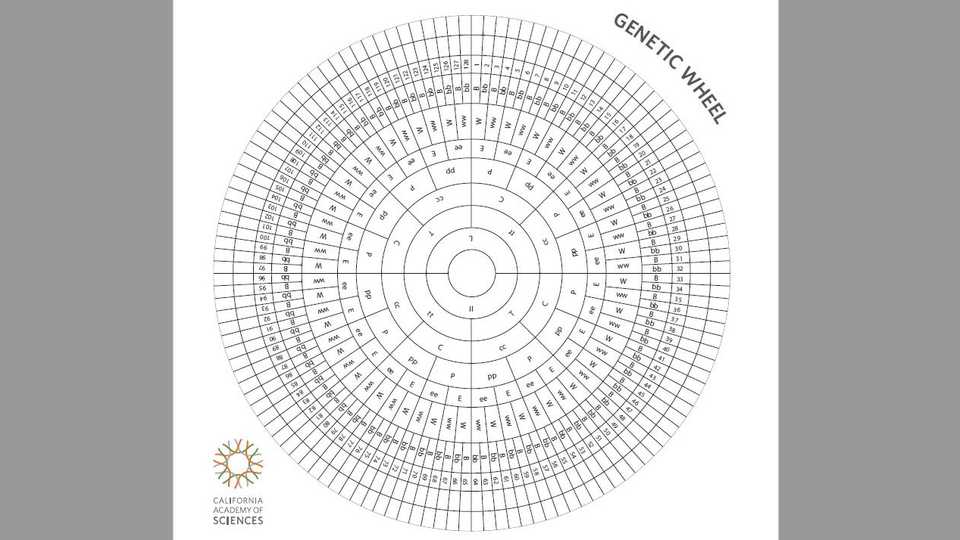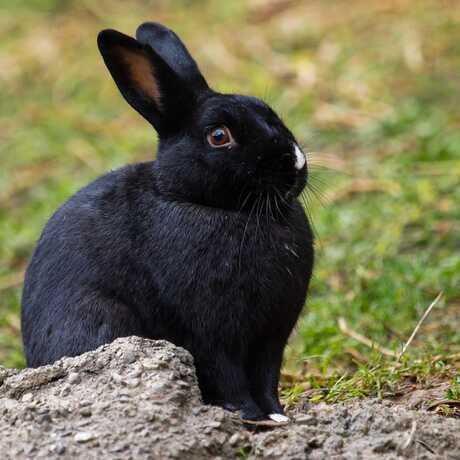
In this activity, students will explore the visible expression of single gene traits in themselves and their classmates.
In this activity, students will:
- be introduced to dominant and recessive alleles.
- map out the variation in single gene traits between themselves and their classmates.
- big genetic wheel
- dry erase markers
- regular markers (1 per student)
- list of human single gene traits (1 per pair of students)
- 8.5x11 genetic wheels (1 per pair of students)
- Extension activity: PTC papers (1 per student)
- DNA (deoxyribonucleic acid): the molecule that contains the genetic information that determines the traits of all living organisms
- gene: a segment of DNA, at a specific location on a chromosome, that is the basic unit of heredity
- allele: one of several forms of the same gene that codes for a particular trait
- dominant allele: an allele whose trait is expressed in the phenotype whenever that allele is present
- recessive allele: an allele whose trait is not expressed in the phenotype whenever the dominant allele for that trait is present
- genetic variation: genetic diversity in a population or species as a result of new gene combinations
- single gene trait: a trait that is determined by one gene with only two alleles, a dominant and a recessive
- heterozygous: having different alleles at one or more corresponding chromosomal loci
- homozygous: having identical alleles at corresponding chromosomal loci
- genotype: the genetic makeup of an organism; all of the genes and alleles of an organism
- phenotype: all observable physical and functional characteristics of an organism; it is the product of the genotype and environmental influences
- locus (plural – loci): a site on a chromosome occupied by a specific gene
- Print enough copies of the list of human traits and the 8.5x11 genetic wheel for each pair of students.
- Put the large genetic wheel on the board or another easily visible location in your classroom.
Ask students to look around the room and notice the variations in size, hair color, eye color, etc. of their classmates. Tell students that they are going to investigate human variation. Specifically they will explore visible, single gene traits. Explain what single gene traits are by using the information provided in the teacher background section. Explain that with these relatively simple traits, people either exhibit the trait or they don’t. There is no gradation.
Explain that students will use a genetic wheel to plot their own traits. Model this activity by using the big genetic wheel to plot your own traits in front of the students. You may need to find models in the class to help show some of the traits.
Begin in the center of the wheel with the “L” and “l” expressions for dimples. If you have dimples, you have the trait resulting from the dominant allele. Color the “L” section and plot the rest of your traits on the top half of the wheel. If you do not have dimples, you have the recessive allele for that trait. Color in the “l” section and plot the rest of your traits on the bottom half of the wheel. Work your way through the list of traits and continue plotting on the wheel until you have reached the numbers on the outside of the wheel. Mark that number.
- Divide students into pairs, explaining that they will help each other plot their traits.
- Distribute a list of human traits, an 8.5x11 genetic wheel, and 2 different colored markers to each pair.
- Have student pairs determine their traits and map them out on their genetic wheel, using different colors for each individual.
- After each pair has finished, gather as a class and have each student report their number so that you can mark it on the big genetic wheel at the front of the class. Or, take turns having students come to the front of the class to mark their own number.
- Comment on the diversity of traits in the class!
As you reflect on your findings, consider the following:
- From where did you get your alleles? (Individuals have two of each chromosome and hence two alleles of each gene, one acquired from each parent. These versions may be identical or may differ from each other.)
- Let's find some examples of homozygous recessive, homozygous dominant, and heterozygous allele combinations for a particular gene trait.
- What differences among individuals in the class do not result from differences in genes? In other words, what variation do you think might be inherited, and what might influenced by environment or culture?
Having genetic variation within a species makes it more likely that some members of a population will survive under changing environmental conditions. Consider facilitating the Breeding Bunnies activity to trace changes in allele frequency over time in a population.
Explain to students that although there seems to be only one gene that controls whether or not people taste bitterness there are more than two possible alleles at this gene locus. Therefore, there are more than two different possible allelic combinations. Those combinations result in gradations of the ability to taste bitterness: some people taste it strongly, others weakly, and still others not at all.
Hand out PTC strips to each student, explaining that researchers have used the compound phenylthiocarbamide (PTC) to test the ability to taste bitterness. This paper contains that compound.
Have each student put the paper in their mouth. Make a table on the board to show how many students tasted bitterness on the paper and how many tasted nothing. Work with your students to calculate the percentage of students that tasted bitterness and the percentage of those that did not.
In general 70% of people can taste PTC and 30% cannot. However, the exact percentages vary depending on the specific population in question. Was your class close to these percentages?
This activity is just one step towards prepare your students to understand the following as part of a larger unit:
Disciplinary Core Ideas
LS3.B: Variation of Traits
- In sexually reproducing organisms, each parent contributes half of the genes acquired (at random) by the offspring. Individuals have two of each chromosome and hence two alleles of each gene, one acquired from each parent. These versions may be identical or may differ from each other.
Coolidge-Stolz, E., Cronkite, D., Jenner, J., Pasachoff, J. M., & Wysession, M. (2008). California: Focus on life science. Boston: Pearson Prentice Hall.
TheTech and Stanford School of Medicine. (2004). Understanding Genetics. Retrieved February 5, 2009 from http://www.thetech.org/genetics/ask.php?id=29


